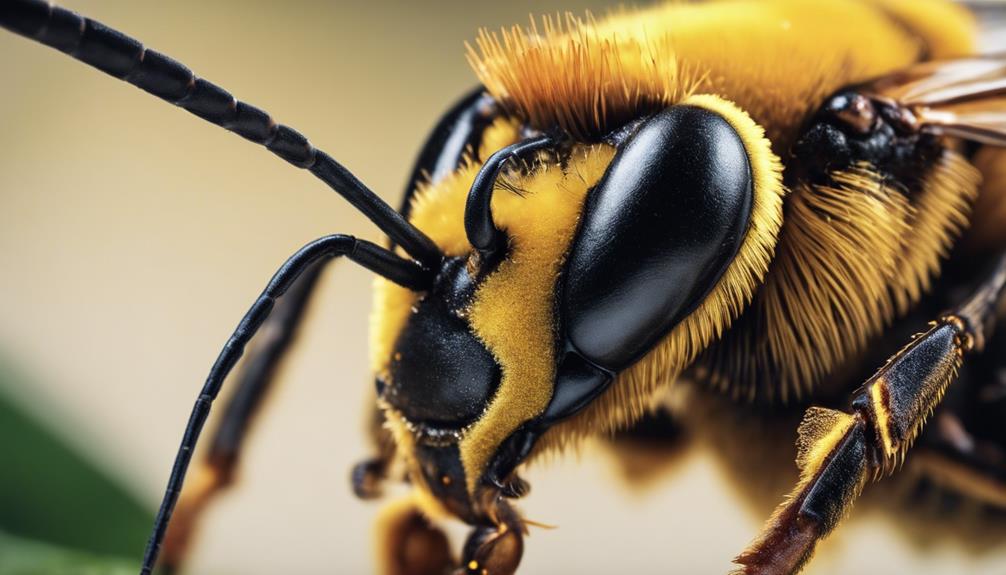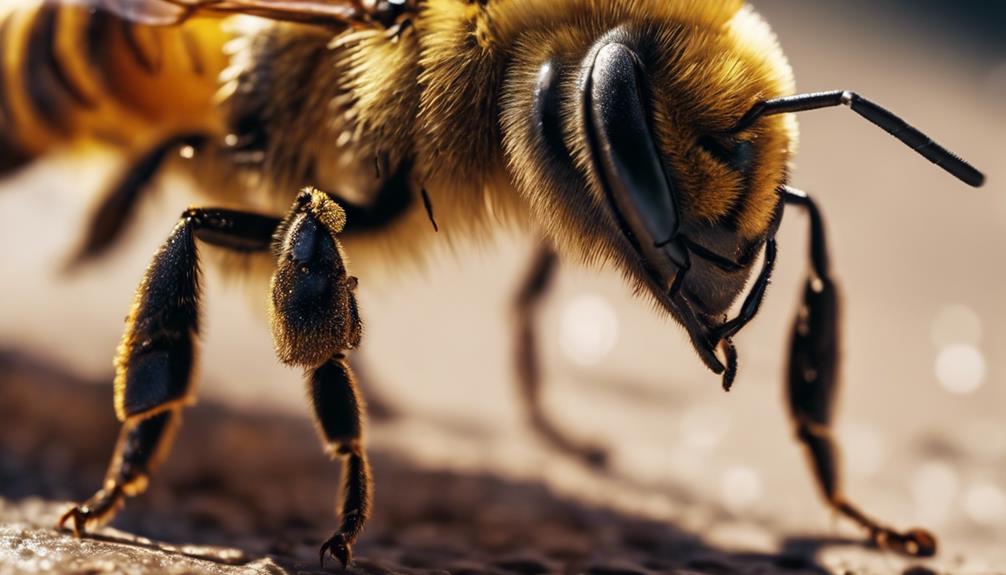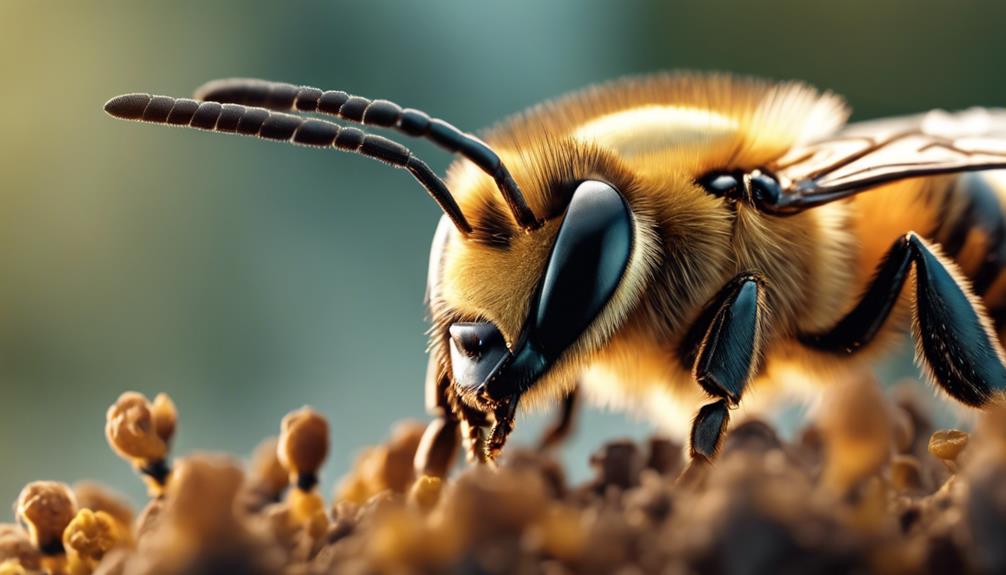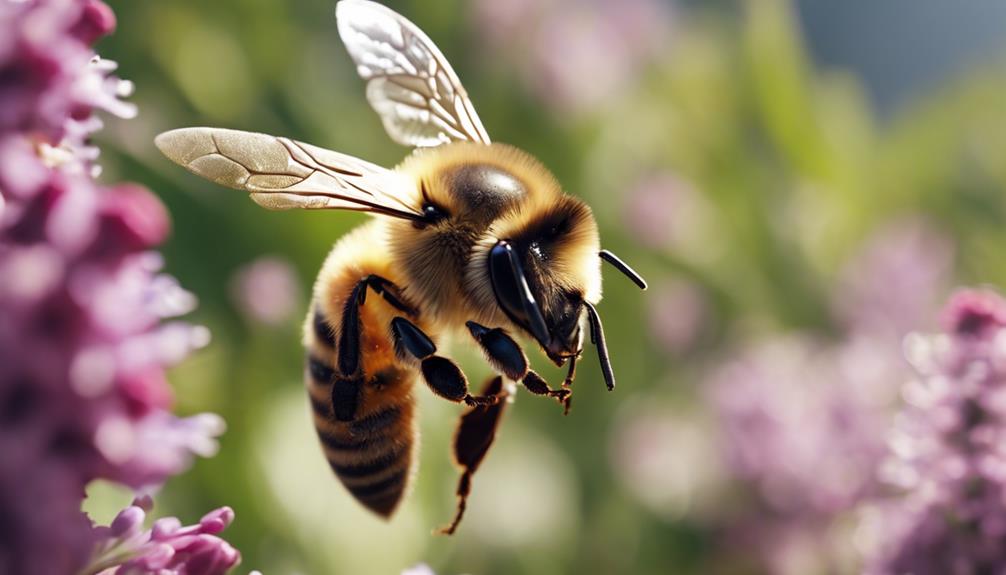Worker bees do indeed sting as an important defense strategy for safeguarding their hive. These bees use barbed stingers that embed in the target, a mechanism that unfortunately results in the bee’s sacrifice for the greater good of the colony. The stingers act like tiny anchors, remaining embedded to deliver venom, which contains histamine and melittin. This venom causes pain, inflammation, and various effects on the victim. Understanding these bee behaviors and mechanisms can help navigate encounters with these essential pollinators. Understanding more about these fascinating creatures can reveal a world of incredible adaptations.
Main Points
- Worker bees sting as a defense mechanism for the hive.
- The stingers are barbed and remain embedded to deliver venom.
- Stings serve the purpose of protecting the colony from threats.
- Stings can be triggered by disruptions near the hive.
- Worker bees can sting multiple times to defend the hive.
Worker Bee Sting Mechanism
When worker bees sting, their barbed stingers embed in the victim’s skin, causing the bees to die as a defense mechanism for the hive. It’s a sacrifice they make to protect their home.
These barbed stingers act like tiny anchors, making it difficult for the bee to pull out without leaving part of its body behind. This unique mechanism guarantees that the stinger remains embedded, delivering venom to the intruder and signaling danger to other bees.
The barbs on the stinger make it effective in warding off threats, but unfortunately, this also leads to the loss of the bee’s life. Understanding this process sheds light on the intricate ways in which worker bees safeguard their colony, showcasing their unwavering dedication to the hive’s safety.
Factors Triggering Bee Stings
In regard to provoking bee stings, specific actions or vibrations near the hive can agitate a worker bee. These little warriors are always prepared to protect their colony, so disruptions or sudden motions close to their residence might lead to a sting.
Understanding what triggers these tiny defenders to strike can help us navigate safely around these essential pollinators.
Bee Sting Causes
Upon perceiving threats, worker bees sting in response to various triggers such as sudden movements, loud noises, dark colors, and strong scents. These factors can set off a chain reaction within the hive, leading to a coordinated defense.
Here are some key causes of bee stings:
- Sudden movements can startle bees and trigger a defensive response.
- Loud noises may disturb the hive and prompt bees to act aggressively.
- Dark colors can be mistaken for predators, causing bees to feel threatened.
- Strong scents, especially those resembling predators or danger, can put bees on high alert.
Understanding these triggers can help us navigate around bees respectfully, minimizing the chances of getting stung.
Bee Sting Prevention
To prevent bee stings, we should be mindful of factors such as sudden movements, strong scents, dark colors, and vibrations that can trigger defensive responses from worker bees. Worker bees sting when they feel threatened, so it’s important to move calmly and avoid disturbing their environment.
When you’re out and about, especially near hives, keep in mind that loud noises or disruptive actions can provoke bees to sting. If you’re wearing dark clothing or strong perfumes, you might inadvertently attract unwanted attention from these diligent insects.
Worker Bee Stinger Anatomy

Worker bees possess barbed stingers, which measure approximately 2.5mm in length and are a modified form of the ovipositor. Understanding the intricate worker bee stinger anatomy is important for grasping its defensive capabilities.
- Derived Design: The worker bee stinger has evolved for defense rather than egg-laying.
- Functional Form: The barbed stingers are specifically structured to deter threats.
- Defensive Duty: Stinging vertebrates can result in autotomy, sacrificing the stinger for the greater good.
- Protective Purpose: The anatomy of the worker bee stinger plays a crucial role in safeguarding the hive against intruders.
Bee Sting Venom Composition
Bee sting venom packs quite a punch, containing components like histamine and melittin that trigger pain and inflammation.
Melittin, the star of the show, is known for its inflammatory effects, making bee stings a memorable experience for many.
Understanding these venom components is key to finding effective ways to deal with the aftermath of a bee’s defense mechanism.
Venomous Bee Defense Mechanism
Analyzing the composition of venom found in bee stings reveals key components responsible for the pain and swelling associated with these defensive mechanisms. Here are four vital elements in bee venom:
- Histamine: This compound triggers inflammation, leading to redness and swelling at the sting site.
- Melittin: A potent peptide that causes pain and tissue damage, enhancing the effects of the sting.
- Worker Bees’ Defense: The venom of worker bees, especially honey bees, is a powerful tool used to protect the hive from threats.
- Barbed Stingers: Worker bees can sting multiple times due to their barbed stingers, making them effective defenders of the colony. Understanding these components helps in treating bee stings effectively.
Effects of Bee Stings
Understanding the effects of bee stings involves analyzing the composition of bee venom and its impact on human health. Bee venom contains histamine and melittin, which are responsible for the pain and inflammation we feel when stung. When a bee stingers, it injects this venom into our skin, causing a reaction that varies depending on the individual’s sensitivity.
Melittin, a key component in bee venom, can have both significant and helpful effects, such as triggering inflammation but also possessing anti-inflammatory properties. In some cases, the removal of the stinger is vital to prevent further venom injection. However, for those who experience an allergic reaction, bee stings can lead to severe symptoms that require immediate medical attention.
It’s essential to be aware of these effects to stay safe and informed around bees.
Treatment for Bee Stings
Quickly removing the stinger after a bee sting can prevent further injection of venom into the skin, aiding in minimizing the discomfort caused by the sting. When dealing with a bee sting, it’s essential to act promptly.
Here are some key points to bear in mind for treating bee stings:
- Remove the Stinger: Be sure to promptly eliminate the stinger to prevent additional venom injection.
- Histamine and Melittin: These components in bee venom are responsible for pain and swelling.
- Topical Treatments: Ponder using topical anesthetics or anti-itch treatments for relief.
- Scientific Backing: Opt for treatments with scientific evidence supporting their effectiveness for worker honey bee stings.
Managing Bee Stings Safely
How can we effectively manage bee stings to guarantee safety and minimize potential risks?
Worker bees come equipped with barbed stingers that can embed in our skin and release venom. If stung, quick removal of the stinger is vital to prevent more venom from entering our bodies. Unlike honey bees, worker bees can sting multiple times, so proper management is key.
First Aid for Bee Stings

When managing bee stings, quick removal of the honeybee stinger is essential to prevent further venom injection. Here are some quick first aid tips for handling bee stings:
- Remove the Stinger: Scrape it off quickly to minimize venom exposure.
- Apply Cold Compress: Ease pain and swelling by applying a cold compress to the affected area.
- Use Topical Treatments: Anesthetics and anti-itch creams can provide relief from bee sting discomfort.
- Avoid Folk Remedies: Stick to scientifically backed treatments for effective relief.
Preventing Bee Stings
To avoid bee stings, it’s essential to be mindful of factors that can attract these insects, such as clothing choices and food exposure. Worker bees sting primarily for hive defense, so wearing bright colors and avoiding floral patterns can help deter them.
Keeping food and drinks covered reduces the chances of attracting bees with sweet scents. When outdoors, be cautious around flowering plants and avoid sudden movements near bees to prevent them from feeling threatened.
Properly disposing of food scraps and garbage also minimizes the risk of encountering bees. Remember, these little creatures have barbed stingers as their defense mechanism, so taking simple precautions can go a long way in ensuring a sting-free environment.
Seeking Medical Help for Stings

Seek out immediate medical assistance for severe allergic reactions to bee stings, particularly if experiencing symptoms like difficulty breathing or swelling in the face.
Here are some essential points to take into account when seeking medical help for bee stings:
- Multiple Stings: If you have been stung multiple times, it’s advisable to seek medical attention to guarantee proper care.
- Infection Signs: Watch out for any signs of infection at the sting site, as this may necessitate medical intervention.
- Unusual Symptoms: If you develop unusual symptoms post-sting, such as dizziness, nausea, or a rapid heartbeat, consult a healthcare professional promptly.
- Allergic Precautions: Individuals with known severe allergic reactions to bee stings should always have an epinephrine auto-injector and wear medical alert jewelry for identification.

Roger Thomas is a seasoned beekeeper and hive architect with a deep-seated passion for sustainable living. His fascination with bees has shaped his professional career, giving him practical and theoretical expertise in bee behavior, colony health, and optimal hive conditions. Roger’s technical skills shine in his bespoke hive creations that cater to the specific needs of diverse bee species, while his sustainable practices promote environmental balance and the wellbeing of the bee population.
As he continues his journey in beekeeping, Roger has become a dedicated advocate for responsible practices and an insightful educator in his field. His posts aim to inspire new beekeepers, underline the importance of sustainability, and showcase the remarkable contribution bees make to our ecosystem. Roger invites you to join him as he delves into the world of bees and the rewarding, honey-sweet art of beekeeping.


